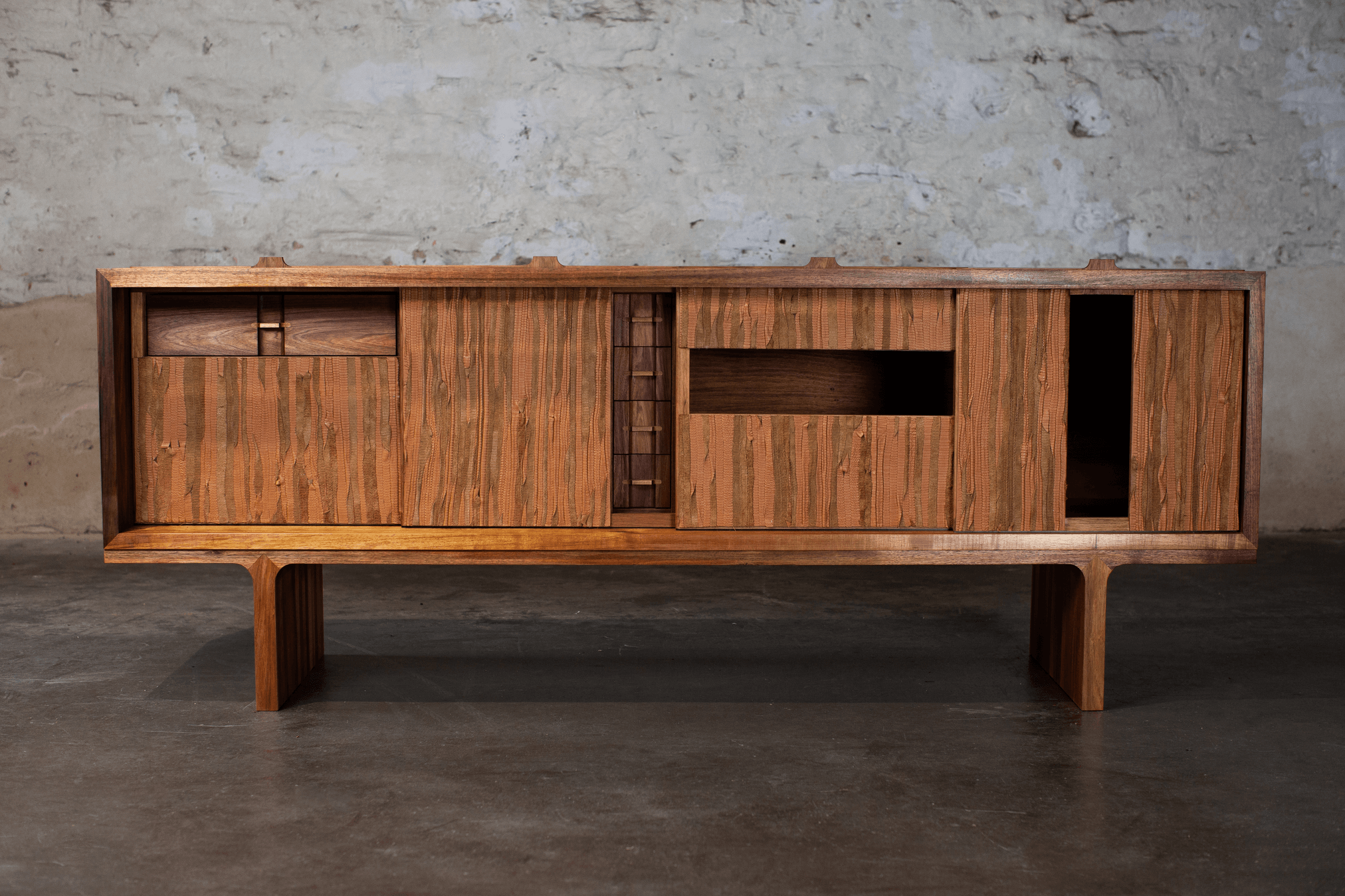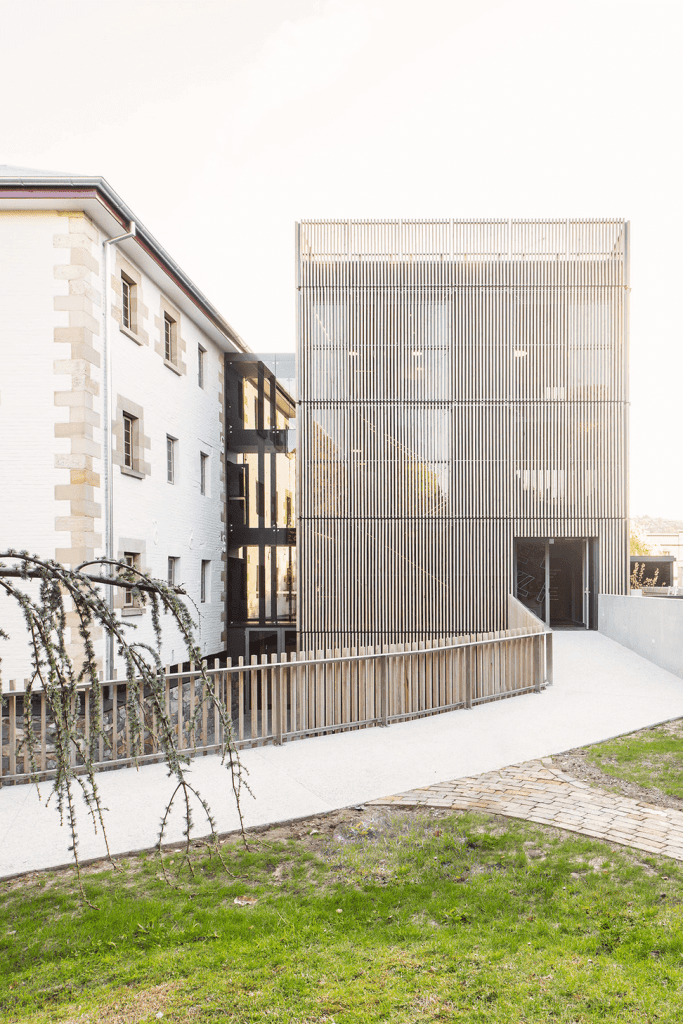Tasmania’s Native Special Species Timber – available for specification
Tasmania, with its unique geography and environment, has some of the finest cool temperate native forests in the world and an expanding hardwood and softwood plantation estate.
Using only the soil, sunlight, water, and carbon dioxide from the air, these forests produce a diverse and premium range of beautiful timbers in substantial quantities. Renowned for almost 200 years, each species has its own character and individual richness.

Michael Lee has been in the timber industry in Tasmania for more than 35 years and is now the Senior Technical Officer at the Center for Sustainable Architecture with Wood at the University of Tasmania. There is no–one more knowledgeable than Michael when it comes to Tasmania’s timber species and the built environment. We asked Michael to share his thoughts on the special species most widely available for specification.
Blackwood
Growing in the swamps and lowlands of Tasmania’s north–west is a timber deeply admired by furniture makers, joiners and architects alike.
One of the best know wattles, Blackwood is easily worked, very stable and long–lasting, and Blackwood artefacts and furniture pieces are always statements of style and quality.
“Blackwood has been the premier furniture material in Australia for a hundred years. Tasmanian retailer, Coogans made Blackwood furniture for the marketplace for decades before closing their doors in 2019.
“Today, Australia’s leading furniture designer–makers, like Jon Goulder, are using Blackwood in their furniture capsules at leading retailers like Spence & Lyda and exhibition platforms like Broached Commissions. It’s a high–end product that’s at the top of the market,” explains Lee.

Boasting a natural variation in colour ranging from light golden–brown to a deep chocolate brown (sometimes with a reddish tint) and occasionally showing black streaks, the timber radiates a subtle beauty.
Additional character results from the grain of the wood, which can be straight or wavy with a natural lustre, attracting interest in Australian homeowners and café owners looking to make an impression.
“Blackwood is on–trend. Blackwood linings are gaining popularity in commercial fit–outs both at home and abroad.
Recently a new London restaurant Mama Fuego has selected Blackwood for its fit–out joining the many Australian hospitality venues (Restaurant Orana, Phat Fish) using the timber to create the perfect entertaining atmosphere.”
“We’ve seen a lot of structural uses of Blackwood in churches and other older buildings but rarely is it used in this way today. It’s now mainly used commercially, often in cafes for acoustic and thermal applications and barriers or set in the traditional home for kitchen fit–outs, cabinetry, bathrooms and flooring if properly coated and detailed.”
Caroma’s recently launched Elvire collection is a beautiful example of Blackwood in a bathroom fit out, and Fitzpatrick+Partners Blackwood kitchen was a finalist in the prestigious Sub–Zero Wolf Awards.
Lee also explains there’s a draw to this timber because of its workability, strength and minimal maintenance as a finished product.
“Blackwood is quite hard but with sharp tools and proper detail it finishes perfectly. With due care, it’s a good product for machining. Blackwood is also easily serviced and a suitable flooring material as well.”
Fast–growing, Blackwood is a common understory species that readily grows from the coast to 1,000m above sea level but it excels in lowland swampy conditions. In Tasmania is available from both terrestrial sources (on land), or reclaimed from the bottom of Lake Pieman.

Celery Top Pine
Celery Top Pine is creamy white when freshly cut and darkens to a mellow rosy gold hue over time and with exposure to sunlight. The timber has distinct annual rings with pronounced latewood. Slowly grown, it has a hardness, strength, and density not normally associated with conifers.
Celery top is light and easy to work. It turns well and has long been employed in the traditional craft of boat building and spindle turning.
“Celery Top was seen as just a boat building material for a long time. Recently, we’ve started to see architects embrace it and have seen some beautiful examples of it in Launceston at the Macquarie House Innovation Hub as an external lining timber and in Sydney in James Fitzpatrick’s Seed House as an internal lining timber.”
While the timber has come into favour for use in other applications, there’s a reason why it’s a popular choice for boat builders.
“Celery Top Pine is great for structurally engineered boat hulls and can easily be steam bent and glued, making it a great choice for boat building.”
The timber is valued for its durability and withstands exposure well, especially in external applications. A tough wood, it provides a hard–wearing surface for flooring and has an attractive fine–grained appearance. Features such as knots and other figure provide character to furniture constructed of Celery Top. Knots are sound and hard, the timber planes and sands well and accepts varnish, stains, and paint readily.
“Celery Top is one of the only Tasmanian Timbers that fits into every category. It’s as good on the outside as it is on the inside and has great durability and makes a great appearance and architectural product.”
“It’s a very practical timber that will last a very long time in most environments. For instance, the Macquarie House Innovation Hub is clad in Celery Top Pine and was chosen because it could withstand the often–inclement weather in Launceston.”
While the timber has come into favour for use in other applications, there’s a reason why it’s a popular choice for boat builders.
“Celery Top Pine is great for structurally engineered boat hulls and can easily be steam bent and glued, making it a great choice for boat building.”
The timber is valued for its durability and withstands exposure well, especially in external applications. A tough wood, it provides a hard–wearing surface for flooring and has an attractive fine–grained appearance. Features such as knots and other figure provide character to furniture constructed of Celery Top. Knots are sound and hard, the timber planes and sands well and accepts varnish, stains, and paint readily.
“Celery Top is one of the only Tasmanian Timbers that fits into every category. It’s as good on the outside as it is on the inside and has great durability and makes a great appearance and architectural product.”
“It’s a very practical timber that will last a very long time in most environments. For instance, the Macquarie House Innovation Hub is clad in Celery Top Pine and was chosen because it could withstand the often–inclement weather in Launceston.”
“Because of its natural durability, Celery Top is a great above–ground material that’s not susceptible to lichen or termites. And unlike a lot of the other timbers that would likely need maintenance, coating or detail over time, Celery Top is fine if left untreated and will naturally and evenly grey off beautifully.”
Prized for its durability for external applications, Lee explains that this also makes it great for indoor use as well, especially in wet areas.
“The wear of Celery Top over time is another feature that makes it a great product. Perfect for wet areas, we’re seeing Celery Top more and more in bathrooms and kitchens. This durability also makes it great for flooring applications in a residential environment.
“From soft whites to pale yellows to warm golds, we see a beautiful colour palette in Celery Top that would accommodate a range of tastes. It’s quite magic to look at.”
Celery Top Pine is available in lower quantities than Blackwood and Myrtle in both terrestrial and reclaimed timber.

-683x1024.png)
Myrtle
It is believed the richness of Myrtle’s colour comes from the quality of the soil it grows in. The deepest red Myrtle comes from highly fertile soils on basalt. The colour is vibrant, combining subtle variations in tone with the texture and sheen of wavy and fiddleback features to produce a surface alive with character and individuality. It is a close–grained species with well–defined annual rings but with little latewood.
Myrtle’s fine aesthetic qualities are matched by its working properties. It is particularly easy to work and makes an excellent veneer, flooring and furniture timber. In fact, it is great for a variety of applications.
“Applications for Myrtle might include flooring, fit–out, joinery, cabinetry and furniture. Myrtle has great wear resistance too. I’ve seen some floors from Myrtle that are 80 years or older, still in perfect condition, that have only been tung oiled,” says Michael.
“Myrtle’s colour palette is very wide which makes it really interesting to use as a floor. It’s a mid–red tone but often has pink, grey, white and yellow hues mixed in. If you’re after something that looks different that’s not homogenized, Myrtle is probably it. No two pieces are ever the same which gives it a big advantage in terms of design.”
Myrtle is a predominant species in Tasmania’s cool temperate rainforests. In wet eucalypt forests, Myrtle grows as an understory tree, and as a small shrub at higher altitudes when the site is exposed to wind. Achieving its best growth in highly organic soils, Myrtle in moist and sheltered conditions will flourish from sea level to 700m, though it can achieve significant growth rates through to 1570m.
Depending on available rainfall and humidity, Myrtle can be fairly fast–growing. In optimum growing conditions, it is capable of regenerating continuously and forests can contain Myrtle trees ranging from 1 to 500 years old.
Myrtle is found in the north–west and west of the state, though small communities thrive on the Tasman Peninsula and South Bruny Island.
“There’s still plenty of Myrtle available for supply with some logs coming out of the forest or being reclaimed from Lake Pieman. We’re using state of the art submerged logging machinery to reclaim the Myrtle that’s been sitting at the bottom of the Hydroelectric dam, which of course comes with a really unique story.”
Depending on available rainfall and humidity, Myrtle can be fairly fast–growing. In optimum growing conditions, it is capable of regenerating continuously and forests can contain Myrtle trees ranging from 1 to 500 years old.
Myrtle is found in the north–west and west of the state, though small communities thrive on the Tasman Peninsula and South Bruny Island.
“There’s still plenty of Myrtle available for supply with some logs coming out of the forest or being reclaimed from Lake Pieman. We’re using state of the art submerged logging machinery to reclaim the Myrtle that’s been sitting at the bottom of the Hydroelectric dam, which of course comes with a really unique story.”
-683x1024.png)
-683x1024.png)